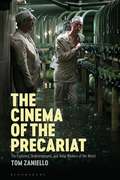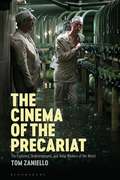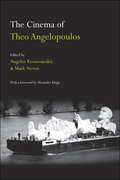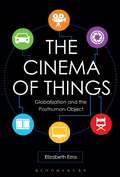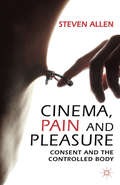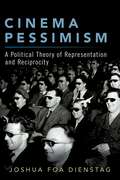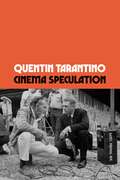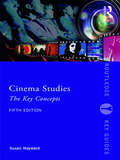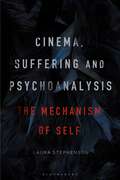- Table View
- List View
The Cinema of Stephen Chow (Global East Asian Screen Cultures)
by Gary Bettinson Vivian P.Y. LeeAn in-depth exploration of the stardom and authorship of Stephen Chow Sing-chi, one of Hong Kong cinema's most enduringly popular stars and among its most commercially successful directors. In the West, Stephen Chow is renowned as the ground-breaking director and star of global blockbusters such as Kung Fu Hustle (2004) and Shaolin Soccer (2001). Among Hong Kong audiences, Chow is celebrated as the leading purveyor of local comedy, popularising the so-called mo-lei-tau (“gibberish”) brand of Cantonese vernacular humour, and cultivating a style of madcap comedy that often masks a trenchant social commentary. This volume approaches Chow from a diverse range of critical perspectives. Each of the essays, written by a host of renowned international scholars, offers compelling new interpretations of familiar hits such as From Beijing with Love (1994) and Journey to the West (2013). The detailed case studies of seminal local and global movies provide overdue critical attention to Chow's filmmaking, highlighting the aesthetic power, economic significance, and cultural impact of his films in both domestic and global markets.
The Cinema of Stephen Chow (Global East Asian Screen Cultures)
by Gary Bettinson Vivian P.Y. LeeAn in-depth exploration of the stardom and authorship of Stephen Chow Sing-chi, one of Hong Kong cinema's most enduringly popular stars and among its most commercially successful directors. In the West, Stephen Chow is renowned as the ground-breaking director and star of global blockbusters such as Kung Fu Hustle (2004) and Shaolin Soccer (2001). Among Hong Kong audiences, Chow is celebrated as the leading purveyor of local comedy, popularising the so-called mo-lei-tau (“gibberish”) brand of Cantonese vernacular humour, and cultivating a style of madcap comedy that often masks a trenchant social commentary. This volume approaches Chow from a diverse range of critical perspectives. Each of the essays, written by a host of renowned international scholars, offers compelling new interpretations of familiar hits such as From Beijing with Love (1994) and Journey to the West (2013). The detailed case studies of seminal local and global movies provide overdue critical attention to Chow's filmmaking, highlighting the aesthetic power, economic significance, and cultural impact of his films in both domestic and global markets.
The Cinema of Tarkovsky: Labyrinths of Space and Time (KINO - The Russian and Soviet Cinema)
by Nariman SkakovIn this book Nariman Skakov explores the phenomenon of spatio-temporal lapse in Tarkovsky's cinema - from Ivan's Childhood (1962) to Sacrifice (1986). He argues that dreams, visions, mirages, memories, revelations, reveries and delusions are phenomena which present alternative spatio-temporal patterns; they disrupt the linear progression of events and create narrative discontinuity. Each chapter is dedicated to the discussion of one of Tarkovsky's seven feature films and, in each, one of these phenomena functions as a refrain. Skakov discusses the influence of the flow of and lapses in space and time on the viewer's perception of the Tarkovskian cinematic universe. He opens and closes his original and fascinating book on Tarkovsky's cinema by focusing on the phenomenon of time that was discussed extensively by the filmmaker in his main theoretical treatise Sculpting in Time, as well as in a number of interviews and public lectures.
Cinema of the Arab World: Contemporary Directions in Theory and Practice (Global Cinema)
by Terri Ginsberg Chris LippardThis volume engages new films and modes of scholarly research in Arab cinema, and older, often neglected films and critical topics, while theorizing their structural relationship to contemporary developments in the Arab world. The volume considers the relationship of Arab cinema to transnational film production, distribution, and exhibition, in turn recontextualizing the works of acknowledged as well as new directorial figures, and country-specific phenomena. New documentary and experimental practices are referenced and critiqued, while commercial cinema is covered both as an industrial product and as one of several instances of contestation. The volume thus showcases the breadth and depth of Arab film culture and its multilayered connections to local conditions, regional affiliations, and the tendencies and aesthetics of global cinema.
Cinema of the Dark Side: Atrocity and the Ethics of Film Spectatorship
by Shohini ChaudhuriCinema of the Dark Side explores how contemporary cinema treats state-sponsored atrocity, evoking multiple landscapes of state terror. This comparative text offers a new perspective on the ethics of spectatorship, providing readers with fresh insights into how we respond to atrocity images and the ethical issues at stake.
The Cinema of the Precariat: The Exploited, Underemployed, and Temp Workers of the World
by Thomas ZanielloThe Cinema of the Precariat is the first book to lay out the incredible range of the precariat (the social class suffering from precarity) as well as a detailed report on the cinematic record of their work and lives.It discusses a thorough and definitive selection of more than 250 films and related visual media that take the measure of the precariat worldwide. For example, thousands of Haitians, including children, harvest sugar cane in the Dominican Republic (The Price of Sugar), while illegal Afghan refugees work in Iran (Delbaran). More familiar are the millions of Latino immigrants, legal or not, of all ages, that work in the United States (Food Chains). Each chapter focuses on a sub-class of the precariat or a contested zone of labor or the evolving political manifestation of the struggles of the unorganized and the dispossessed. Among the hundreds of bewildering film choices available nowadays this book offers the reader reliable guidance to the films bringing to life the economic, political, and social dilemmas faced by millions of the world's global workforce and their families.
The Cinema of the Precariat: The Exploited, Underemployed, and Temp Workers of the World
by Thomas ZanielloThe Cinema of the Precariat is the first book to lay out the incredible range of the precariat (the social class suffering from precarity) as well as a detailed report on the cinematic record of their work and lives.It discusses a thorough and definitive selection of more than 250 films and related visual media that take the measure of the precariat worldwide. For example, thousands of Haitians, including children, harvest sugar cane in the Dominican Republic (The Price of Sugar), while illegal Afghan refugees work in Iran (Delbaran). More familiar are the millions of Latino immigrants, legal or not, of all ages, that work in the United States (Food Chains). Each chapter focuses on a sub-class of the precariat or a contested zone of labor or the evolving political manifestation of the struggles of the unorganized and the dispossessed. Among the hundreds of bewildering film choices available nowadays this book offers the reader reliable guidance to the films bringing to life the economic, political, and social dilemmas faced by millions of the world's global workforce and their families.
The Cinema of Theo Angelopoulos
by Angelos Koutsourakis Mark StevenThe Cinema of Theo Angelopoulos is the first critical assessment of one of the leading figures of modernist European art cinema. Assessing his complete works, this groundbreaking collection brings together a team of internationally regarded experts and emerging scholars from multiple disciplines, to provide a definitive account of Angelopoulos’ formal reactions to the historical events that determined life during the twentieth and early twenty-first centuries. Refusing to restrict its approach to the confines of the Greek national film industry, the book approaches his work as representative of modernism more generally, and in particular of the modernist imperative to document its allusive historical objects through artistic innovation. Retrospective in nature, The Cinema of Theo Angelopoulos argues that Angelopoulos’ films are not emblems of a bygone historical and cultural era or abstract exercises in artistic style, but are foreshadowing documents that speak to the political complexities and economic contradictions of the present.
The Cinema of Theo Angelopoulos
by Angelos Koutsourakis Mark StevenThe Cinema of Theo Angelopoulos is the first critical assessment of one of the leading figures of modernist European art cinema. Assessing his complete works, this groundbreaking collection brings together a team of internationally regarded experts and emerging scholars from multiple disciplines, to provide a definitive account of Angelopoulos’ formal reactions to the historical events that determined life during the twentieth and early twenty-first centuries. Refusing to restrict its approach to the confines of the Greek national film industry, the book approaches his work as representative of modernism more generally, and in particular of the modernist imperative to document its allusive historical objects through artistic innovation. Retrospective in nature, The Cinema of Theo Angelopoulos argues that Angelopoulos’ films are not emblems of a bygone historical and cultural era or abstract exercises in artistic style, but are foreshadowing documents that speak to the political complexities and economic contradictions of the present.
The Cinema of Things: Globalization and the Posthuman Object
by Elizabeth EzraThis book explores the border zones between life and non-life as represented in cinema from the end of the nineteenth century, when France led the global film industry, to the first decades of the twenty-first century, when world film markets are dominated by Hollywood. Informed by both the Internet of Things and the Parliament of Things, The Cinema of Things examines cinematic depictions of the ways in which human beings are prosthetically engaged with life beyond the self in the global age: by hyperconsumption; by structures of racial and sexual objectification that reduce people designated as "others†? to objects of fascination, sexual gratification, warfare, or labor; and by information technology that replaces human agency with encoding. Consumer culture, a key feature of globalization, posits that we must supplement ourselves with commodities without which we would otherwise be incomplete: but these prostheses, rather than enhancing us, end up creating the insufficiencies they were meant to overcome. We are engulfed by objects, to the extent that we ourselves are becoming objectified. At the same time, objects, especially technological objects, are becoming increasingly autonomous, assuming roles that were once the preserve of human agency. We are becoming the objects of globalization, and cinema imaginatively represents this transformation, but it also offers us the possibility of retaining our humanity in the process.
The Cinema of Things: Globalization and the Posthuman Object
by Elizabeth EzraThis book explores the border zones between life and non-life as represented in cinema from the end of the nineteenth century, when France led the global film industry, to the first decades of the twenty-first century, when world film markets are dominated by Hollywood. Informed by both the Internet of Things and the Parliament of Things, The Cinema of Things examines cinematic depictions of the ways in which human beings are prosthetically engaged with life beyond the self in the global age: by hyperconsumption; by structures of racial and sexual objectification that reduce people designated as “others” to objects of fascination, sexual gratification, warfare, or labor; and by information technology that replaces human agency with encoding. Consumer culture, a key feature of globalization, posits that we must supplement ourselves with commodities without which we would otherwise be incomplete: but these prostheses, rather than enhancing us, end up creating the insufficiencies they were meant to overcome. We are engulfed by objects, to the extent that we ourselves are becoming objectified. At the same time, objects, especially technological objects, are becoming increasingly autonomous, assuming roles that were once the preserve of human agency. We are becoming the objects of globalization, and cinema imaginatively represents this transformation, but it also offers us the possibility of retaining our humanity in the process.
The Cinema of Yorgos Lanthimos: Films, Form, Philosophy
by Eddie FalveyFrom the critical and commercial fanfare his films generate, it is largely understood that Yorgos Lanthimos is one of the more interesting filmmakers to have emerged out of the new century. A markedly transnational filmmaker, between Dogtooth and The Favourite Lanthimos has managed to traverse the gap between the art-house and mainstream while not once sacrificing his unique style and worldview. His films, while often difficult, showcase his talents as a filmmaker, collaborator, and commentator on the human condition. Accompanied by a trademark acerbic wit, Lanthimos's films take aim at humanity's more contemptible and absurd designs as he explores a thematic preoccupation with, among other things, power, trauma, isolation, sex, and violence. This edited collection covers everything from an early career that was marked by experimentation with a range of different media to international festival hits including Dogtooth, The Lobster, The Killing of a Sacred Deer, and the Academy Award-winning "historical" epic The Favourite, Lanthimos's most successful feature to date. All his work demonstrates a fascinating contravention of aesthetic, thematic, and generic boundaries that forms the basis of some of the analyses to be found here. Featuring a roster of talented scholars, both new and established, The Cinema of Yorgos Lanthimos: Films, Form, Philosophy provides a timely compendium of critical approaches to one of the most distinct voices in contemporary film.
The Cinema of Yorgos Lanthimos: Films, Form, Philosophy
From the critical and commercial fanfare his films generate, it is largely understood that Yorgos Lanthimos is one of the more interesting filmmakers to have emerged out of the new century. A markedly transnational filmmaker, between Dogtooth and The Favourite Lanthimos has managed to traverse the gap between the art-house and mainstream while not once sacrificing his unique style and worldview. His films, while often difficult, showcase his talents as a filmmaker, collaborator, and commentator on the human condition. Accompanied by a trademark acerbic wit, Lanthimos's films take aim at humanity's more contemptible and absurd designs as he explores a thematic preoccupation with, among other things, power, trauma, isolation, sex, and violence. This edited collection covers everything from an early career that was marked by experimentation with a range of different media to international festival hits including Dogtooth, The Lobster, The Killing of a Sacred Deer, and the Academy Award-winning "historical" epic The Favourite, Lanthimos's most successful feature to date. All his work demonstrates a fascinating contravention of aesthetic, thematic, and generic boundaries that forms the basis of some of the analyses to be found here. Featuring a roster of talented scholars, both new and established, The Cinema of Yorgos Lanthimos: Films, Form, Philosophy provides a timely compendium of critical approaches to one of the most distinct voices in contemporary film.
Cinema, Pain and Pleasure: Consent and the Controlled Body
by Steven AllenFrom Tattoo to Saw, this book considers mainstream cinema's representation of the viscerally dominated and marked body. Examining a shift in the late twentieth century to narratives that highlight subjection, endurance and willed-acquiescence, it probes the confluence of pain, pleasure and consent to analyse the implications of the change.
Cinema Pessimism: A Political Theory of Representation and Reciprocity
by Joshua Foa DienstagAesthetic and political representation are often treated separately, but this book argues that film offers a unique perspective through which to understand the dangers to equality and freedom that lurk in representative politics. The potential problems of representative democracy have long been debated: does it cultivate apathy and discourage citizen participation? What does it mean to be faithfully or well represented in a democracy? And how can appropriate, meaningful representation be achieved? Here, these questions are addressed from a new perspective. Representation, Joshua Foa Dienstag argues, can create the illusion of freedom and reciprocity in place of the real thing, and in both cinema and politics, what gives us pleasure is not the same as what secures or supports our existence as free and equal citizens. As this book shows, there are political dangers not visible within the current debates around democratic representation, dangers we can better understand and help to minimize by considering the way that human beings interact, emotionally, with their filmic representations. Dienstag looks at a series of films that directly confront issues of representation (Her, Blade Runner, The Man Who Shot Liberty Valance, Melancholia, and the Up documentary series) to diagnose these hazards and consider how best to respond to them. Each chapter looks at a specific film as emblematic of a different conception or problem of representation often ignored by mainstream political debates (such as reciprocity, happiness, boundaries, evil) to show that the relationship between representation and freedom is fraught with tension. This book continues Dienstag's earlier groundbreaking work on philosophical pessimism, understood not as something despairing, but as a rejection of the idea that these necessary tensions can be cured. Ultimately, Dienstag seeks to defend a kind of pessimistic politics that might produce a better sort of democratic representation than what we have today.
Cinema Raw: Shooting and Color Grading with the Ikonoskop, Digital Bolex, and Blackmagic Cinema Cameras
by Kurt LancasterWith the next generation of raw cinema cameras you can finally shoot professionally with uncompressed raw motion pictures—without compromising your image or your budget. In Cinema Raw: Shooting and Color Grading with the Ikonoskop, Digital Bolex, and Blackmagic Cinema Cameras, Lancaster takes you through the birth of these new cameras and includes an exclusive behind-the-scenes look at Digital Bolex. He field tests each camera and discusses the importance of shooting in raw and guides you through the raw color grading process so you can create stunning films. Interviews with professionals who have shot documentaries, shorts, and promotionals with these cameras are featured throughout, allowing you to learn field production techniques under real world conditions. FEATURES: Behind-the-scenes case studies for the next generation of low budget cinema cameras Recommended gear lists to begin your raw shooting experience Full color post workflows that help you realize your boldest cinematic visions A companion website (www.kurtlancaster.com) featuring raw projects covered in the book; video interviews with the creators of the Digital Bolex, Joe Rubinstein and Elle Schneider; and resources for further study of raw cinema
Cinema Raw: Shooting and Color Grading with the Ikonoskop, Digital Bolex, and Blackmagic Cinema Cameras
by Kurt LancasterWith the next generation of raw cinema cameras you can finally shoot professionally with uncompressed raw motion pictures—without compromising your image or your budget. In Cinema Raw: Shooting and Color Grading with the Ikonoskop, Digital Bolex, and Blackmagic Cinema Cameras, Lancaster takes you through the birth of these new cameras and includes an exclusive behind-the-scenes look at Digital Bolex. He field tests each camera and discusses the importance of shooting in raw and guides you through the raw color grading process so you can create stunning films. Interviews with professionals who have shot documentaries, shorts, and promotionals with these cameras are featured throughout, allowing you to learn field production techniques under real world conditions. FEATURES: Behind-the-scenes case studies for the next generation of low budget cinema cameras Recommended gear lists to begin your raw shooting experience Full color post workflows that help you realize your boldest cinematic visions A companion website (www.kurtlancaster.com) featuring raw projects covered in the book; video interviews with the creators of the Digital Bolex, Joe Rubinstein and Elle Schneider; and resources for further study of raw cinema
Cinema Speculation
by Quentin TarantinoA unique cocktail of personal memoir, cultural criticism and Hollywood history by the one and only Quentin Tarantino.The long-awaited first work of nonfiction from the author of the number one New York Times bestselling Once Upon a Time in Hollywood: a deliriously entertaining, wickedly intelligent cinema book as unique and creative as anything by Quentin Tarantino.In addition to being among the most celebrated of contemporary filmmakers, Quentin Tarantino is possibly the most joyously infectious movie lover alive. For years he has touted in interviews his eventual turn to writing books about films. Now, with CINEMA SPECULATION, the time has come, and the results are everything his passionate fans - and all movie lovers - could have hoped for. Organized around key American films from the 1970s, all of which he first saw as a young moviegoer at the time, this book is as intellectually rigorous and insightful as it is rollicking and entertaining. At once film criticism, film theory, a feat of reporting, and wonderful personal history, it is all written in the singular voice recognizable immediately as QT's and with the rare perspective about cinema possible only from one of the greatest practitioners of the artform ever.
Cinema Studies: The Key Concepts
by Susan HaywardCinema Studies: The Key Concepts is an essential guide for anyone interested in film. Providing accessible coverage of a comprehensive range of genres, movements, theories and production terms, this is a must-have guide to a fascinating area of study and arguably the greatest art form of modern times. Now fully revised and updated for its fourth edition, the book includes new topical entries such as: CGI Convergence Cult cinema Digital cinema/Post-digital cinema Dogme 95• Movement-image/Time-image Quota quickies 3-D technology
Cinema Studies: The Key Concepts
by Susan HaywardCinema Studies: The Key Concepts is an essential guide for anyone interested in film. Providing accessible coverage of a comprehensive range of genres, movements, theories and production terms, this is a must-have guide to a fascinating area of study and arguably the greatest art form of modern times. Now fully revised and updated for its fourth edition, the book includes new topical entries such as: CGI Convergence Cult cinema Digital cinema/Post-digital cinema Dogme 95• Movement-image/Time-image Quota quickies 3-D technology
Cinema Studies: The Key Concepts (Routledge Key Guides)
by Susan HaywardCinema Studies: The Key Concepts is essential reading for anyone interested in film. Providing accessible coverage of a comprehensive range of genres, movements, theories and production terms, this is a must-have guide to a fascinating area of study and arguably the greatest art form of modern times. Now fully revised and updated for its fifth edition, the book includes entries on topics such as: Acting Audience CGI Convergence Cult cinema Digitisation and globalization Distribution Experimental film Transnational cinema World cinemas
Cinema Studies: The Key Concepts (Routledge Key Guides)
by Susan HaywardCinema Studies: The Key Concepts is essential reading for anyone interested in film. Providing accessible coverage of a comprehensive range of genres, movements, theories and production terms, this is a must-have guide to a fascinating area of study and arguably the greatest art form of modern times. Now fully revised and updated for its fifth edition, the book includes entries on topics such as: Acting Audience CGI Convergence Cult cinema Digitisation and globalization Distribution Experimental film Transnational cinema World cinemas
Cinema Studies: The Key Concepts (Routledge Key Guides)
by Susan HaywardNow in its sixth edition, this essential guide for students provides accessible definitions of a comprehensive range of genres, movements, world cinemas, theories and production terms. This fully revised and updated book includes new topical entries that explore areas such as film and the environmental crisis; streaming and new audience consumption; diversity and intersectionality; questions related to race and representation; the Black Lives Matter movement; and New Wave Cinemas of Eastern European countries. Further new entries include accented/exilic cinema, border-cinema, the oppositional gaze, sonic sound and Black westerns. Existing entries have been updated, including discussion of #MeToo, and more contemporary film examples have been added throughout. This is a must-have guide for any student starting out on this fascinating area of study and arguably the greatest art form of modern times.
Cinema Studies: The Key Concepts (Routledge Key Guides)
by Susan HaywardNow in its sixth edition, this essential guide for students provides accessible definitions of a comprehensive range of genres, movements, world cinemas, theories and production terms. This fully revised and updated book includes new topical entries that explore areas such as film and the environmental crisis; streaming and new audience consumption; diversity and intersectionality; questions related to race and representation; the Black Lives Matter movement; and New Wave Cinemas of Eastern European countries. Further new entries include accented/exilic cinema, border-cinema, the oppositional gaze, sonic sound and Black westerns. Existing entries have been updated, including discussion of #MeToo, and more contemporary film examples have been added throughout. This is a must-have guide for any student starting out on this fascinating area of study and arguably the greatest art form of modern times.
Cinema, Suffering and Psychoanalysis: The Mechanism of Self
by Laura StephensonCinema, Suffering and Psychoanalysis explores psychological disorder as common to the human condition using a unique three-angled approach: psychoanalysis recognises the inherent suffering encountered by each subject due to developmental phases; psychology applies specific categorisation to how this suffering manifests; cinema depicts suffering through a combination of video and aural elements. Functioning as a culturally reflexive medium, the six feature films analysed, including Black Swan (2010) and The Machinist (2004), represent some of the most common psychological disorders and lived experiences of the contemporary era. This book enters unchartered terrain in cinema scholarship by combining clinical psychology's Diagnostic and Statistical Manual Five (DSM-V) to organise and diagnose each character, and psychoanalysis to track the origin, mechanism and affect of the psychological disorder within the narrative trajectory of each film. Lacan's theories on the infantile mirror phase, the Imaginary, and the Symbolic, Žižek's theories on the Real, the big Other and the Event, and Kristeva's theories on abjection and melancholia work in combination with the DSM's classification of symptoms to interpret six contemporary pieces of cinema. By taking into consideration that origin, mechanism, affect and symptomatology are part of an interconnected group, this book explores psychological disorder as part of the human condition, something which contributes to and informs personal identity. More specifically, this research refutes the notion that psychological disorder and psychological health exist as a binary, instead recognising that what has traditionally been pathologised, may instead be viewed as variations on human identity.




